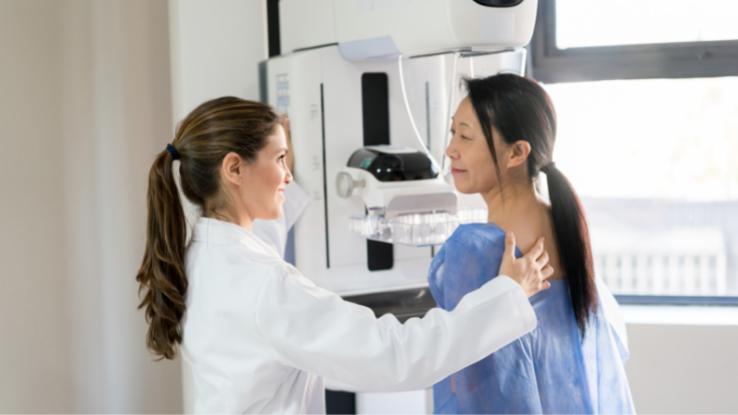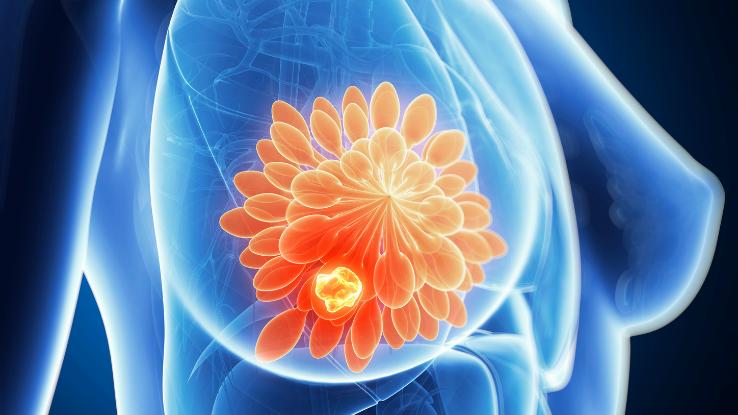What Vitamins and Supplements to Take After Breast Cancer Treatment to Limit Recurrance
Breast Cancer: Risk Factors, Symptoms & Treatment

When malignant cancer cells form and abound inside a person's breast tissue, chest cancer occurs. Although it is the most commonly diagnosed cancer in American women, breast cancer tin can impact people of all genders. The American Cancer Society estimates that over 280,000 women and over 2,600 men will exist newly diagnosed with invasive chest cancer in 2021 — and well-nigh 43,000 women and 530 men will dice from breast cancer.
Hither, we'll provide an overview of chest cancer — from the different types to risk factors, symptoms and treatments — to give you a better motion-picture show of the disease and its impacts.
Types of Breast Cancer
Breast cancer is a malignancy in which the cells of the chest split up and grow at a faster-than-typical rate and can, over time, form tumors in the breast. Without treatment, malignant tumors tin can spread to other parts of the body.
While well-nigh breast cancers start in the milk ducts, some malignancies form first in the glandular tissue. Moreover, many tumors grow slowly: it may have as long as 10 years for a patient to be able to feel the tumor in their chest. Nevertheless, in some instances, the tumor may be aggressive and grow at a much faster pace.
What you may non realize is that there are different types of chest cancer. The categorizations refer to the location of the cancer'south origin and whether information technology's considered invasive or non-invasive. Invasive breast cancer refers to cancer cells that take traveled from their original location and take invaded surrounding tissue; in later on stages, this blazon of cancer may spread to the lymph nodes or one's organs. On the other hand, non-invasive cancers, sometimes referred to as "carcinoma in situ," are confined to the point of origin and have not spread to otherwise salubrious tissue.
With this in listen, types of breast cancer include:
- Ductal Carcinoma In Situ (DCIS): In this most common form of not-invasive chest cancer, making up around 1 in v new diagnoses, malignant cells develop inside the milk ducts and remain in place. Although DCIS is non a life-threatening cancer, it can increase your chances of developing invasive cancer later on.
- Lobular Carcinoma In Situ (LCIS): Like DCIS, LCIS remains within its identify of origin and is not-life threatening. LCIS occurs when abnormal cells have adult in the milk-producing glands. LCIS is not thought of as a truthful form of chest cancer, only an instance of LCIS can put you at a higher risk for developing chest cancer in the future
- Invasive Ductal Carcinoma (IDC): This form of cancer, sometimes referred to as infiltrating ductal carcinoma, is the nearly common class of invasive breast cancer, affecting almost 80% of all patients with invasive chest cancer. IDC begins in the milk ducts merely, eventually, the cancer cells volition break through the duct walls and attack the surrounding tissue.
- Invasive Lobular Carcinoma (ILC): ILC is the second-most common form of invasive breast cancer. In an instance of ILC, the cancer cells originate in the milk-producing glands, or lobules, and spread into nearby healthy tissue.
Other rare types of breast cancer include inflammatory breast cancer, angiosarcoma and Paget'southward disease.
Symptoms Associated With Chest Cancer
In most cases, folks with early-stage breast cancer won't exhibit signs or symptoms. In fact, cancer is oftentimes first detected by a routine mammography. Nonetheless, symptoms of breast cancer may include:
- A lump or mass felt in the chest
- An area of thickened tissue in the breast
- A alter in the size of shape of your breast
- Swelling in or around the breast
- Irritation of the skin of the breast
- Dimpling of the skin of the breast
- Rashes on the breast
- Pain in the breast or nipple expanse
- Changes in the appearance of the nipple or surrounding pare.
- Discharge from the nipple
- Lump in the underarm area
Changes to the breast or surrounding area may be related to other medical conditions. Any unusual changes should be brought to your doctor's attention immediately.
Diagnosis & Investigations
Diagnosis of breast cancer involves a physical test by a doctor; use of imaging; and, oftentimes, a biopsy of the abnormal tissue. So, what are the specifics associated with these procedures?
Imaging
- Mammogram: This procedure uses small amounts of x-ray beams to visualize the chest tissue.
- Ultrasound: This process uses a pocket-size probe placed on the peel of the breast to see the underlying tissue. Ultrasound may be more suitable for younger women with chest lumps
Tissue Sampling
- Needle Aspiration: A small needle is used to take a sample of the aberrant breast cells, or if fluid is present (a cyst), a sample of fluid may be taken
- Needle Biopsy: A small core of tissue is removed with a needle, this allows for visualization of the cells
Farther Tests
- Computed Tomography (CT) Browse: May exist used to come across if at that place is evidence of spread of chest cancer elsewhere in the body.
- Chest X-Ray: Used to look specifically at the lungs to meet if there is whatever bear witness of spread.
- Claret Tests: Used to check your blood counts, liver part, kidney office and sometimes to perform genetic testing.

Staging
When diagnosing breast cancer, your md volition try to determine its phase. Staging normally uses the TNM system which takes into account the size of the tumor (T), if it has spread to any lymph nodes (Northward) and if it has metastasized (M).
Tumour Size (T)
- T0 = primary tumor cannot be seen
- T1 = tumor is ≤ 20mm
- T2 = tumor is > 20mm simply ≤ 50mm
- T3 = tumor is > 50mm
- T4 = tumor of any size which extends to the chest wall or skin
Nodes
- N0 = no evidence of spread to lymph nodes
- N1 = metastases to e.one thousand. 1–3 axillary lymph nodes
- N2 = metastases to due east.chiliad. 4–ix axillary lymph nodes
- N3 = metastases to e.g. ≥ 10 axillary lymph nodes or to infraclavicular lymph nodes
Metastasis
- M0 = no evidence of distant metastasis
- M1 = evidence of afar metastasis
Other factors, such equally which receptors your type of cancer has on its cells, is likewise usually included in this conception. Those other factors include:
- Human epidermal growth factor-2 (HER2)
- Estrogen (ER)
- Progesterone (PR)
These parameters are ofttimes combined to give an overall "stage" of the cancer:
- Stage 1: The tumor is pocket-sized (
- Stage 2: The tumor measures 2–5cm, and there is prove of nearby lymph nodes being afflicted, however there is no signs of spread to other places in the trunk
- Stage 3: The tumor measures 2–5cm and there is evidence that nearby lymph nodes and nearby structures are afflicted, but in that location is no sign of distant spread
- Stage four: The cancer has spread to other parts in the torso.
Notation: This is not an exhaustive listing of staging parameters as these can exist much more complicated.
Grading
Grading of breast cancer is a measure of how "normal looking" the cells are at the fourth dimension of exam. These grades include:
- G1 = low histological course (favorable)
- G2 = intermediate histological grade (moderately favorable)
- G3 = loftier histological grade (unfavorable)
Note: Depression-form cells look more normal than loftier-class cells.
Screening & Detection
Screening tests have the ability to detect cancer early on on — when it'southward almost responsive to handling. Equally such, people should perform self-breast exams and report any changes to their physician.
Moreover, a baseline mammogram is recommended for all women at twoscore years old; betwixt the ages of 40 to 49, experts recommend that women schedule mammograms every i to two years based upon earlier results, adventure factors, and so on. If whatsoever abnormalities are present, your medico may send yous for farther testing to either diagnose or rule out cancer.
Causes & Hazard Factors
There is no definitive crusade for breast cancer, but many hazard factors are associated with the affliction, including:
- Having a family unit history of chest cancer (eastward.m. in your mother, sister or aunt)
- Increasing historic period
- Being overweight or obese
- Maintaining an unhealthy diet or lifestyle
- Early menstruation or late menopause
- The use of some types of nascency command pills for more 10 years
- Radiation to the chest to treat another condition at an early on age
- Using hormone replacement therapy
- Smoking

Chest Cancer Treatment
In that location have been incredible advancements made in the treatment of chest cancer. As a consequence, the charge per unit of deaths due to breast cancer has been on the turn down. Treatment options may include surgery, radiation, chemotherapy and hormonal therapy. Moreover, your treatment program will depend on the blazon and stage of breast cancer you have, as well as your medical history and personal preference.
- Surgery: Surgical options include a lumpectomy, which removes only the malignant tissue and leaves the chest looking normal, and/or a mastectomy, in which the unabridged breast is removed. Mastectomy and lumpectomy may or may non be used in conjunction with other treatments, such every bit radiation.
- Radiation: The process of using high force ten-rays aimed directly at the cancer cells to kill them.
- Chemotherapy: This process uses drugs to deteriorate or kill cancer cells. Hormone therapy can merely be used with certain types of chest cancer, those that are hormone receptor positive.
Integrative and Complementary Medicine
Integrative and complementary therapies can exist used in conjunction with traditional medical practices to ease symptoms or improve quality of life. While some complementary therapies have been proven effective, no one should ever use this blazon of therapy in the place of standard medical therapy. Integrative and complementary therapies include, but are not limited to, herbal supplements, acupuncture, meditation, massage and psychotherapy.
Prognosis
Prognosis depends on the blazon and phase of breast cancer. Someone diagnosed with either not-invasive or early-stage invasive breast cancer may take a ameliorate survival rate than those diagnosed with late-stage and/or invasive cancer. Undoubtedly, phase 4 cancer that has spread to other areas of the torso and throughout the lymph nodes has the poorest prognosis.
If you have whatsoever additional questions or concerns regarding breast cancer, contact your healthcare professional.
Resource Links:
- "Cancer Statistics: 2021 Estimates: Breast" via American Cancer Society
- "Chest Cancer" via Medline Plus
- "Breast Cancer" via The American Academy of Family Physicians
- "Breast Cancer" via Mayo Dispensary
- "Chest Cancer" via American Cancer Club
- "Assessment of breast mass" via BMJ Best Exercise
- "Patient Information from the BMJ: Breast Cancer: DCIS" via BMJ All-time Practice
- "Breast Cancer" via National Health Service (NHS)
- "National Breast and Cervical Cancer Early Detection Programme" via Centers for Disease Command and Prevention (CDC)
- "Breast Cancer" via Centers for Affliction Command and Prevention (CDC)
Source: https://www.symptomfind.com/health-conditions/condition-breast-cancer?utm_content=params%3Ao%3D740013%26ad%3DdirN%26qo%3DserpIndex
Post a Comment for "What Vitamins and Supplements to Take After Breast Cancer Treatment to Limit Recurrance"